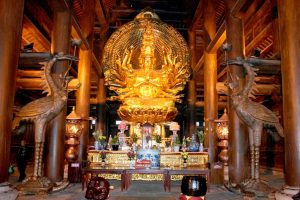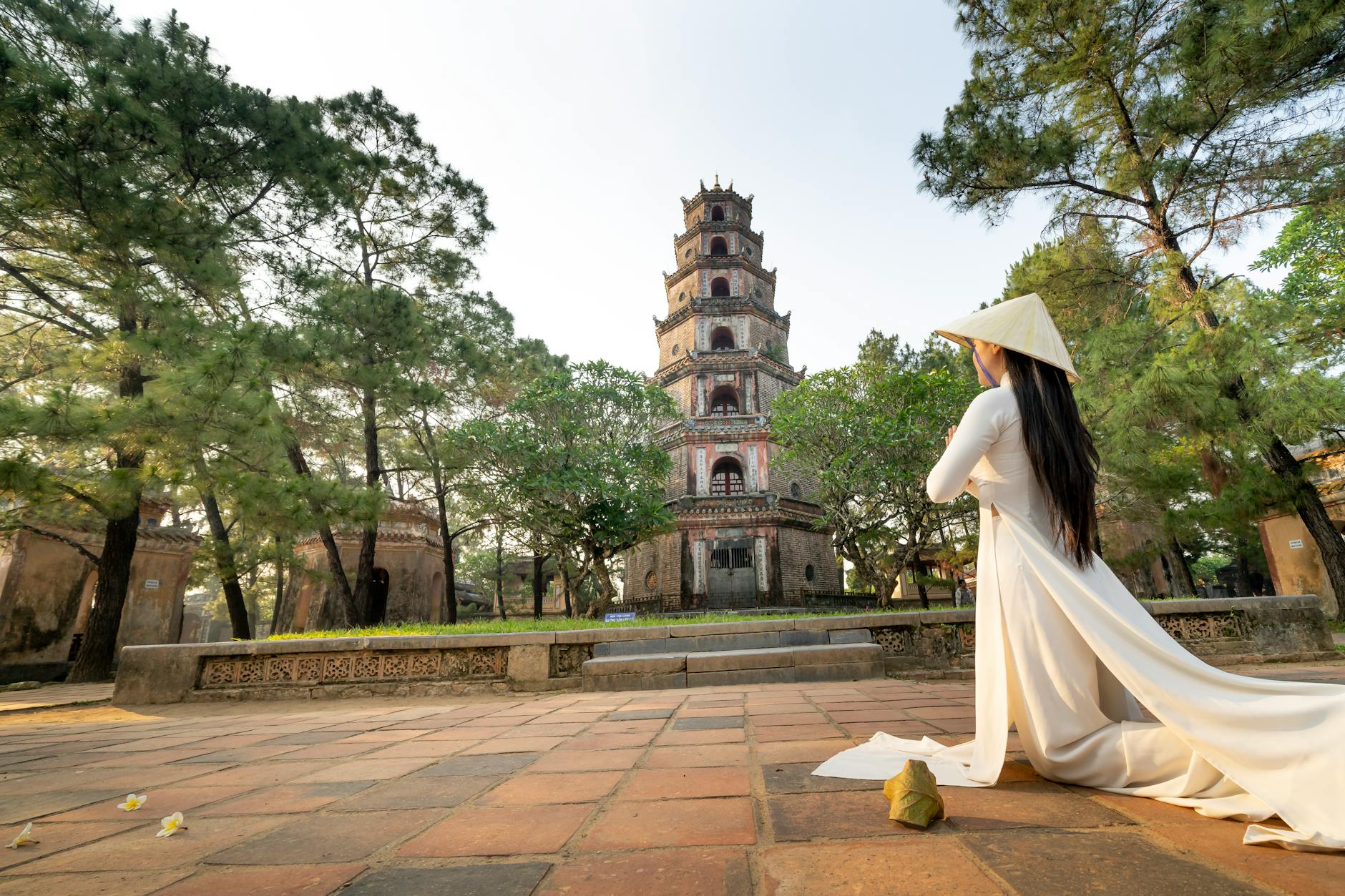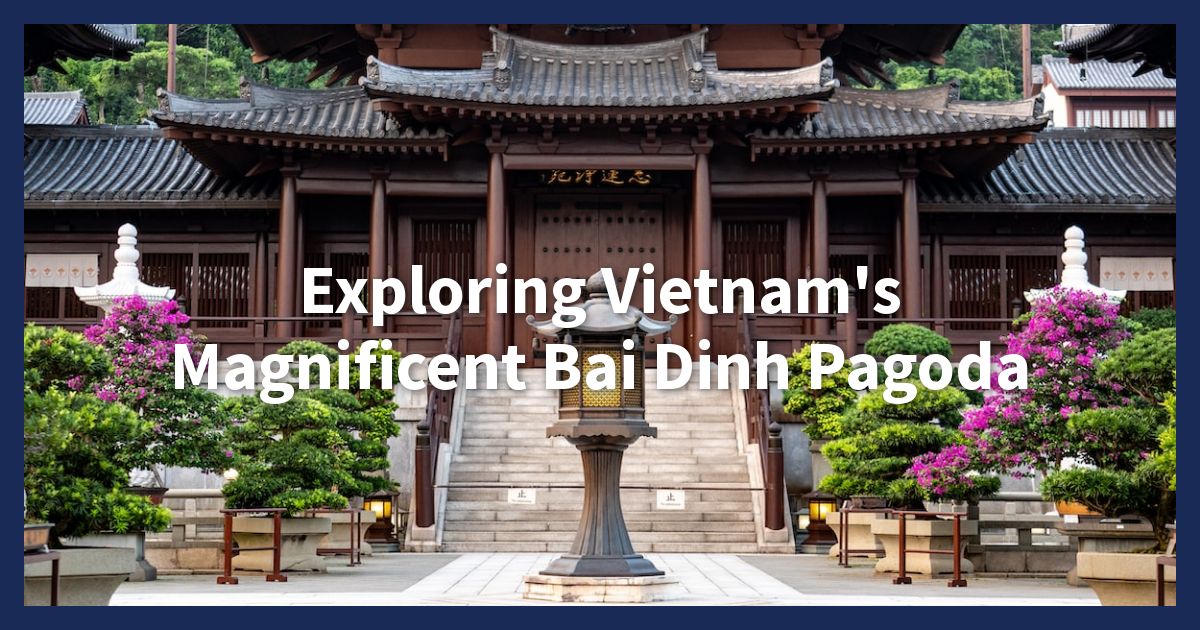The Bai Dinh Temple, also known as the Bai Dinh Temple Spiritual and Cultural Complex, is a vast complex of Buddhist temples located on Bai Dinh Mountain in Gia Vien District, Ninh Binh Province, Vietnam. This complex is considered the largest of its kind in Vietnam and has become a popular site for Buddhist pilgrimages from across the country.
The compound consists of an original old temple and a newly created larger temple, and it is a part of a famous tourist attraction site of Ninh Binh Province. The new Bai Dinh Temple covers an area of 700 hectares and includes various structures built over several phases, with construction beginning in 2003 and finally completed in 2010. The temple’s architecture follows traditional lines, consisting of large halls, courtyards, and enclosures.
Exploring the Largest Pagoda in Vietnam: Bai Dinh
Bai Dinh Pagoda holds a significant place in Vietnamese culture and history. Its story is deeply rooted in the history of the country, and its grandeur reflects the importance it holds in the hearts of the Vietnamese people.
The History of Bai Dinh Pagoda
The history of Bai Dinh Pagoda traces back to ancient times, with its origins dating back to the 13th century. Initially built on the orders of King Ly Thai To, it has undergone several expansions and renovations over the centuries. The pagoda complex encompasses both ancient and modern architectural elements, blending the traditional with the contemporary.
The Significance of Bai Dinh in Vietnamese Culture
Bai Dinh Pagoda is not only the largest pagoda in Vietnam but also a revered spiritual site, drawing pilgrims and visitors from all over the world. Its significance lies in its role as a center for Buddhist practice and its cultural importance as a symbol of spiritual enlightenment and national pride. The pagoda complex is a testament to the rich cultural heritage of Vietnam, showcasing a blend of traditional and contemporary Vietnamese architecture.
 Photo by Braven Nguyen
Photo by Braven Nguyen
The Architectural Marvel of Bai Dinh Pagoda
Bai Dinh Pagoda, located in Ninh Binh, Vietnam, stands as a testament to the rich architectural heritage of the region. The site is home to both ancient and new temples, boasting distinctive features that showcase the evolution of Vietnamese religious architecture.
The Ancient and New Temples
The complex comprises an ancient temple and a newly constructed one. The ancient temple, with its weathered stone walls and intricate carvings, exudes an aura of history and spirituality. In contrast, the new temple showcases modern architectural elements while staying true to traditional design principles. Together, these temples offer visitors a captivating journey through time, seamlessly blending the old and the new.
Key Architectural Features
The architectural features of Bai Dinh Pagoda are a sight to behold. Intricately adorned gates, towering pillars, and elaborately designed rooftops create a mesmerizing ensemble. The meticulous craftsmanship evident in the ornate details reflects the skill and dedication of the artisans who brought this grand vision to life. Each element tells a story, inviting visitors to appreciate the depth of Vietnamese architectural artistry.
The Record-Setting Bell of Bai Dinh
One of the most remarkable attractions at Bai Dinh Pagoda is its record-setting bell. Towering in stature and resounding with a sonorous chime, this bell holds a place of significance within the pagoda’s grounds. Its sheer size and historical importance make it a captivating feature, drawing visitors to admire its grandeur and understand its cultural relevance.
Spiritual and Religious Aspects of Bai Dinh
Bai Dinh Pagoda complex, situated in Ninh Binh, is a revered spiritual destination boasting significant historical events in Vietnam. The esteemed religious compound spans 539 hectares, making it the largest pagoda in Vietnam and one of Southeast Asia’s foremost Buddhist complexes.
Do Explore these too
The Grand Buddha Statues
The pagoda’s grandeur is exemplified by remarkable features, including the captivating Bell Tower and Kuan-Yin Hall. The Bell Tower houses a striking bronze bell and drum, while the Kuan-Yin Hall showcases an awe-inspiring 80-ton statue of Bodhisattva, constructed from the most precious wood.
Additionally, the large Buddha temple within the compound captivates visitors with its exceptional architecture and houses the majestic Thich Ca Buddha statue, weighing 100 tons and standing at 10 meters, a remarkable testament to spiritual reverence.
 Photo by Tran Duc
Photo by Tran Duc
The Bodhi Tree
While there are no images available, the spiritual significance of the Bodhi Tree within the Bai Dinh Pagoda complex cannot be overstated. It serves as a powerful symbol of enlightenment, rooted in Buddhist tradition, and offers visitors a serene space for contemplation and reflection.
Arhat Hall
The nearly 13km-long Corridor of Arhat statues, housing 500 stone statues carved in diverse forms, stands as a remarkable testament to the pagoda’s cultural and artistic heritage. Crafted by skilled artisans from renowned handicraft villages in North Vietnam, these statues make this corridor the longest Arhat statue corridor in Asia and a true marvel for visitors.
These awe-inspiring elements at Bai Dinh Pagoda punctuate its status as a revered spiritual and religious sanctuary, drawing Buddhists and tourists from around the globe.
Bai Dinh Pagoda Festivals and Events
The Bai Dinh Pagoda Festival, celebrated in Ninh Binh, Vietnam, is a grand event that honors not only the Buddha and Gods but also commemorates significant historical figures such as Quang Trung and Dinh Bo Linh. The festival has evolved into a solemn and vibrant occasion designed to bring together people of all ages in celebration.
The Bai Dinh Pagoda Festival
The festival, once lasting only a week, now spans the entire spring season, offering visitors ample time to revel in the joyful atmosphere and stunning surroundings. The event attracts numerous tourists, transforming from a local tradition into a must-see attraction that fills the hearts of Ninh Binh’s residents with pride.
Special Celebrations and Ceremonies
During the Bai Dinh Pagoda Festival, the local community meticulously prepares colorful processions, floats, costumes, traditional musical performances, and flag-holding ceremonies. The pagoda is adorned with vibrant crowds eagerly awaiting their turn to partake in the festivities.
Visitors can immerse themselves in the unique atmosphere, explore Vietnamese culture, and engage in traditional games such as wrestling, “ném còn,” and tug of war. Additionally, various stalls showcase local produce, offering a glimpse into the region’s culinary heritage.
Visiting Bai Dinh Pagoda
Bai Dinh Pagoda, the largest Buddhist complex in Southeast Asia, offers a serene and culturally rich experience to visitors. When planning a visit, timing is crucial to ensure an optimal experience. The best time to visit Bai Dinh Pagoda is during the spring months of February to April, when the weather is mild and the landscape is adorned with blooming flowers, enhancing the natural beauty of the surroundings.
Moreover, visiting early in the morning or late in the afternoon allows for a more peaceful and uncrowded exploration of the pagoda complex.
Best Time to Visit Bai Dinh
The ideal time to visit Bai Dinh Pagoda is during the spring season, specifically from February to April, to enjoy the pleasant weather and vibrant flora. During this time, the pagoda complex exudes a tranquil ambiance, making it an ideal setting for sightseeing and spiritual reflection.
However, it’s important to avoid the peak tourist season to fully appreciate the spiritual and architectural marvels without the distraction of large crowds.
Tips for Tourists
- Respect the Dress Code: As a place of worship, visitors are expected to dress modestly, covering their shoulders and knees as a sign of respect to the religious sanctity of the pagoda.
- Arrive Early or Late: To avoid heavy foot traffic and fully absorb the peaceful ambiance, plan your visit for the early morning or late afternoon.
- Photography Etiquette: While photography is allowed, be mindful of the sanctity of the site and refrain from disruptive behavior when capturing moments.
- Guided Tours: Consider joining a guided tour to gain in-depth knowledge of the pagoda’s history and significance, enhancing your overall experience.
- Weather Preparation: Be prepared for fluctuating weather by carrying sunscreen, a hat, and a light jacket, especially during the transitional seasons.
By adhering to these tips, visitors can make the most of their visit to Bai Dinh Pagoda and partake in an enriching cultural and spiritual journey.

Photo by Quang Nguyen Vinh
Preserving Bai Dinh Pagoda for Future Generations
The preservation of Bai Dinh Pagoda, the largest complex of Buddhist temples in Vietnam, is an essential endeavor for conserving its cultural and historical significance for future generations. Conservation efforts are crucial to maintain the structural integrity and cultural authenticity of this architectural marvel.
Conservation Efforts
Conservation efforts at Bai Dinh Pagoda involve meticulous restoration and preservation processes to protect its ancient structures, artifacts, and religious relics. The use of traditional building materials, such as wood and stone, along with modern conservation techniques, ensures that the pagoda maintains its historical authenticity while withstanding the test of time.
Additionally, ongoing research and monitoring help identify potential risks and implement proactive measures to safeguard the pagoda from natural and human-induced threats.
The Role of Visitors in Preservation
Visitors play a crucial role in the preservation of Bai Dinh Pagoda. By adhering to respectful conduct and following designated pathways, visitors contribute to the preservation of the pagoda’s delicate architectural elements and cultural artifacts.
Furthermore, the awareness raised among visitors about the historical and religious significance of the site fosters a sense of responsibility towards its conservation. Through responsible tourism practices and adherence to preservation guidelines, visitors become integral partners in ensuring that Bai Dinh Pagoda endures for generations to come.
The preservation of Bai Dinh Pagoda is a collective responsibility, and the collaborative efforts of conservationists, local communities, and visitors are essential to protect and sustain this cultural treasure.
Conclusion
In conclusion, Bai Dinh Temple is a significant spiritual and cultural complex in Vietnam, attracting Buddhist pilgrims from all over the country. The new complex, completed in 2010, covers a vast area and showcases traditional architectural elements.
As part of the famous tourist attractions in Ninh Binh Province, Bai Dinh Temple stands out for its grandeur and historical importance. Whether for religious pilgrimage or tourism, this temple complex offers a unique and memorable experience for visitors.
